
Wine Culture and Information since 2002 - Volume 22
 Wine Culture and Information since 2002 - Volume 22 |
|
Issue 41, May 2006 |
Contents |
|
|
Wine Emotions |
|
By looking back to the past, to all the writings our ancestors left to us as a witness of their times and their cultures, among all beverages created by man, wine is the one which has been more frequently mentioned and it occupies a place of absolute importance. A truly singular fact, if we think we are talking about a “simple” beverage, that is something which, in its primary and essential function, should be used to quench thirst. Nevertheless wine is rarely drunk in order to quench thirst, indeed, when one is thirsty, wine is hardly thought as the solution. This is not only because of the deprecable and obvious effects caused by its abuse, first of all because wine has always played a primary role in social and cultural events among the people in which it was present, without excluding - of course - the high ritual importance to which this beverage was associated in many religions and cults. If we think to Christian religion, wine is essential in celebrating Eucharist, a ritual element considered as sacred, which therefore goes beyond the simple concept of beverage. With time, wine leaves its primary role of sacred beverage, it becomes a social beverage of communion, friendship, aggregation and union. It is not by chance the most important moments in the life of men are still today celebrated by wine, consumed as a beverage to wish good luck for agreements, the celebration of special events. In this sense, wine is still today considered as a sacred beverage. Despite social and ritual meanings which have been recognized to wine in the course of time, it is however undeniable wine is also a beverage capable of giving emotions. A good glass of wine - where to the word “good” everyone gives an absolutely personal meaning - it is capable of giving emotions, to satisfy a sensorial need, to have a moment of wellness. Is wine therefore capable of giving emotions? The answer seems to be, of course, obvious: certainly yes. If we ask ourselves about the kind of emotions a wine can give, the answer is certainly more complex: maybe it is even impossible to find an answer. The emotions a wine can give are in fact countless, as for everyone wine represents something absolutely personal. Something which goes beyond the simple act of drinking. Wine emotions are also associated to past events, persons met in the past and with whom we shared part of our lives and special moments, which are remembered with pleasure or with a negative feeling. Wine emotions are not only associated to the memories they can recall about a particular person, a specific producer, a particular grape or area. Emotions are also given by that truly personal conversation which takes origin in front of a glass of wine, a conversation which is not made by words, indeed, it is made by sensations, that is emotions. Emotions can be felt when we watch the color and the appearance of a wine in the glass: sometimes colors, nuances and brightness found in a wine are as charming as the colors of a sunset. Emotions are also given by the aromas which come out from the glass: there are wines that with time and patience can develop truly fascinating aromas that one could spend hours in listening to them. The great Luigi Veronelli - who is certainly missed by anyone in the world of wine, not only for all the things he did before anyone else in Italy for the beverage of Bacchus - in his truly personal communicative style, has created many words and definitions, now of common use, capable of describing the personality of a wine. For all those wines capable of catching the attention, to give emotions to the senses like a good friend, he created the effective definition meditation wines, capable of countless words and emotions, which can give a moment of wellness, of strong and satisfying emotions, that is, of meditation. The German writer Patrick Süskind in its novel “Perfume” recalls that «whoever dominates perfumes, dominates the heart of men». A definition which is pretty impossible not to agree, just because of the strong effects smells and aromas have in giving emotions to human beings. And how many emotions can give the aromas of a good wine? Endless, including the aromas capable of making us be in a field of flowers or in front of a rich basket of fruits, for example. The emotions a wine can give are not limited to the ones caused by the appearance or aromas: the taste can give emotions as well. Also in this case the many faces of wine taste are virtually endless, not only for the sensations of taste. In fact, emotions a sweet wine can give are different from the ones given by a red wine or a sparkling wine. Just like for aromas, also tastes are frequently associated to memories, to particular moments of life, memories of the past which in a moment become clear and strong in our mind. And it is also amazing to find in the mouth the flavors which amazed the nose first, not only a quality factor, but also the confirmation of what the nose promised. The emotion of taste goes beyond the moment in which wine is swallowed and - some more and some less - continue to give emotions with their taste olfactory persistence. It is also amazing to measure the time in which the taste of wine can be strongly felt in the mouth, until disappearing from our senses and becoming a memory. If we see things like this, wine seems to be a supreme beverage, almost perfect, in which we can see positive aspects only, or better to say, positive emotions. Of course, it is not like that. There also are negative emotions associated to wine, including, for example, speculations which can be done with the beverage of Bacchus, to overestimate it and to turn it into something it is not. The same can be said for the emotions - which are probably negative, but we should ask the ones who look for this kind of emotions in a wine - given by a deprecable consumption of wine which causes the negative effects we all know. After all, wine can be for men everything they want it to be and this is also true for every other thing. Positive, negative, amazing, surprising, charming, depressing, noxious or deprecable, it simply is a matter of choice. It is up to the one who decides to have wine to emphasize or to listen to the aspect which is considered the most attractive one, or simply useful in a particular moment. And it clearly is a choice the abuse of wine, something which can be hardly agreed. Maybe even in the stupidity of the abuse can be found an emotion, as well as can be found an emotion in the wisdom of being capable of loyally appreciating things, to understand them, and to listen to them, including wine and people.
|
||||
MailBox |
|
In this column are published our reader's mail. If you have any comment or any
question or just want to express your opinion about wine, send your letters to
our editorial or fill in
the form available at
our site.
|
| I bought a bottle of Terre de Trinci's Sagrantino di Montefalco 2000. I tried to find it in your guide but it is not present: after vintage 1999 there is vintage 2001. Why? |
| Sandro Cafasso -- Rome (Italy) |
| DiWineTaste's Wines Guide, as opposed to other similar guides, is not created according to seasonal or yearly criteria; in the guide are found the wines evaluated and tasted by our committee only. The wines for review are usually selected in one of the following ways: the interest of our committee to talk about a specific producer, the interest of a producer to be present in our pages or because our readers asked us to give an opinion about a wine or a producer. For this reason, it can happen some vintages are not present, as well as some producers. However, the invitation we give producers in reviewing their wines is never limited to a single month or a single review, but also to subsequent vintages, while however leaving this decision to the producer. Despite we explicitly invite producer to send the whole range - in order to give a better information to our readers as well as to give a continuity about the performance of a wine - you may have noticed that for many wines there are successive vintages available in our guide, however it is up to the producer to decide every year which wines should be sent to us for sensorial evaluation and for reviewing. |
| I recently had a Californian wine made with 100% Petite Syrah. Is it a grape related to Syrah? |
| Meredith Nicholson -- New York (USA) |
| The Petite Syrah is a grape mainly cultivated in California and, although it was believed in the past to be genetically similar to Syrah, today it is known to be the Durif grape, once very common in the Rhône, France, and today almost disappeared from those areas. Petite Syrah produces wines with deep colors, good body and aromatic hints of black pepper, a quality which probably associated this grape to the renowned Syrah. Despite the grape is from France - it is a crossing created by Dr. Durif and named after him in its original version - Petite Syrah seems to give the best results in California, where he reached notoriety in the 1970's. Despite the cultivation of Petite Syrah is today diminished, many wineries use it for the production of mono varietal full bodied wines. Moreover, today Petite Syrah is typically added to other grapes - such as Zinfandel - in order to add complexity and body. |
Trentino Alto AdigeThe charming Italian region, at the feet of Alps and made of two distinct geographical areas, is protagonist of magnificent white wines, as well as red and classic method sparkling wines |
|
There is a region in Italy which is getting more and more popular for the production of white wines - and not only for them - with an impeccable elegance and class, characterized by an explosion of aromas and flavors of fruits and flowers: Trentino Alto Adige. According to an administrative point of view, the region is divided in two provinces, the northern one, at the feet of Alps with strong cultural and traditional German influence, Alto Adige or Sudtirolo (Südtirol in the local language), and the southern one, with culture and tradition similar to the Italian ones, Trentino. Both areas however have in common an excellent wine production, also thanks to the favorable geographical position and local climate conditions, allowing the reaching of good results, in particular with the classic grapes which like cool climate areas, such as Sauvignon Blanc and Pinot Noir. Despite in Trentino Alto Adige are cultivated many “international” varieties, in the region the presence of autochthonous grapes is interesting as well. History tells us the cultivation of the vine and the production of wine in this land began in 700 b.C., when the area belonged to Raetia, renowned in ancient times for the quality of its wines which competed with the legendary Falerno. The wine of Raetia has illustrious supporters of the past, Pliny the Elder, Columella and Cassiodore. Despite the viticulture in this region was strongly promoted and developed by ancient Romans, the practice of cultivating the vine is however older and dates back to the times of Etruscans. On this regard, it is interesting mentioning a finding in Val di Cembra of a situla - a small wine bucket - of the Reto-Etruscan era. A finding which is not casual, as in Val di Cembra, at those times, it was practiced the cult of Sileno, the preceptor of Bacchus. When ancient Romans arrived in these lands, they found the vine trained in structures made of wood, a system which is considered the ancestor of modern pergola.
Moreover, it seems in this region ancient Romans got to know about the use of wood cask for the keeping and transportation of wine: at those times they still had the custom of using earthenware vases and amphorae. Viticulture and wine production become important in this region - just like in other parts of Europe - at the times of Charlemagne as episcopates and abbeys in southern Germany were used to buy the wines produced in these areas. With the arrive of Barbarians and their devastations, most of viticulture was destroyed - sharing the same fate with other lands - therefore determining a strong decline in the production of wine even in future centuries. In the eighth century Frankish and Bavarian monasteries began cultivating vineyards in order to make the wine needed for the liturgy. The work of monks - in particular Benedictines - for the keeping and development of viticulture and wine production fundamental, just like in other regions of Europe. Monks saved most of the grape varieties of the region and it is believed since those times in Trentino Alto Adige were already cultivated Lagrein, Schiava and Gewürztraminer grapes - varieties which are still renowned in the area - as well as other autochthonous varieties which have extinguished today. Viticulture was practiced by monks inside the walls of their monasteries and this allowed a further development of viticulture and its safeguarding. Wine production drastically changed in the following centuries when it was subjected to changes and alternates fates in trading, until the sixteenth century when - in occasion of the Council of Trento - the Ecclesiastes who met there for the occasion had the chance to appreciate the wines of the region, therefore contributing to their spreading and notoriety all over Europe. The substantial contribution of monks for the viticulture of Trentino Alto Adige saw its decline in 1803, in occasion of Napoleonic wars, when Austria lost the dominion in these lands. Abbeys and monasteries were secularized and their properties - including vineyards - were given to private people. Beginning from 1867, thanks to the inauguration of Brennero railway connection, the production of wine in Trentino Alto Adige had a new commercial boost, therefore allowing the wines of this region to be known outside the borders of Italy, as well as determining the beginning of wine cooperatives. This period of commercial splendor and notoriety for Trentino Alto Adige's wine was strongly slowed down, not with the arrive of phylloxera - as it could be easily supposed - but in particular with the beginning of World War One. Phylloxera arrived in these lands in the beginning of 1900's and, despite it severely damaged vineyards, it did not cause the strong decline which was common in other European regions instead. After having been the main provider of wines for the imperial courts of Austria, at the end of World War One, when both Trentino and Alto Adige were annexed to Italy, the production and trading of wine had a strong decline. Only at the end of World War Two it will be seen the first signs of recovery for the enology of Trentino Alto Adige. Here, just like in other Italian regions, the recovery was characterized by a production mainly focused on quantity instead of quality. A strong recovery for the enology of Trentino Alto Adige - and of all Italy - began in the 1980's, after having understood the success of wine - not only commercial - required the adoption of strict quality criteria while abandoning the speculative politics of quantity. The change was strong and the result can be seen today as a prove of the tenacious efforts of local producers for quality, and now Trentino Alto Adige is considered one of the best wine areas in Italy, both for the production of white and red wines, as well as for the production of classic method sparkling wines.
|
||||||||||||
|
The wines of Trentino Alto Adige are regulated by the quality system in force in Italy which provides for the categories Vini da Tavola (table wines), Indicazione Geografica Tipica (IGT, Typical Geographic Indication), Denominazione d'Origine Controllata (DOC, Denomination of Controlled Origin) and Denominazione d'Origine Controllata e Garantita (DOCG, Denomination of Controlled and Guaranteed Origin). Despite the quality of Trentino Alto Adige's wines has strongly increased in the course of the last twenty years, in the region are not defined any DOCG areas. Trentino Alto Adige is a region with a strong and historical tradition in the production of red wines, however the region is mainly known for its excellent white wines, which take advantage of the cool climate giving a pleasing and lively acid hint. According to an enological point of view, Trentino and Alto Adige are seen as two distinct areas, most of the times the denominations of the two areas are preceded by the mention of the respective provinces. The denominations currently defined in Trentino are: Caldaro or Lago di Caldaro, Casteller, Teroldego Rotaliano, Trentino which includes the sub areas Sorni, Isera and Ziresi, Trento and Valdadige. The denominations of Alto Adige are: Alto Adige or Südtiroler which includes the sub areas Colli di Bolzano, Meranese di Collina, Santa Maddalena, Terlano, Valle d'Isarco and Val Venosta, Caldaro or Lago di Caldaro and Valdadige.
|
|
Trentino, the southern province of the region, is mainly known for the production of red wines, in particular with the grapes Teroldego, absolute protagonist of this area, and Marzemino, famous for having being mentioned by Lorenzo Da Ponte in the libretto of Mozart's opera Don Giovanni, who in the second act made the protagonist say «Versa il vino! Eccellente Marzemino!» (Pour the Wine! Excellent Marzemino!). The citation seems to be a homage to the famous composer from Salisburg who seemed to like Marzemino wine. In Trentino, more precisely in the denomination Trento DOC, there is an interesting production of classic method sparkling wines. For the production of these wines are allowed Chardonnay, Pinot Blanc, Pinot Noir and Pinot Meunier grapes, alone or in different percentages. The minimum period of refermentation and aging on yeast in the bottle must be at least 15 months, in case the period is of at least 24 months, in the label can be mentioned vintage. Sparkling wines aging for at least 36 months in bottle are classified as riserva (reserve), a category which is allowed for white sparkling wines only, whereas for the other categories it is also allowed the production of rose wines. In the northern part of Trentino, in the plain of Campo Rotaliano, the absolute protagonist of wines is Teroldego, a red berried grape among the most interesting of the region. Teroldego Rotaliano - this is the complete name of the DOC - is produced in different styles, from light bodied wines to full bodied and well structured wines which can certainly surprise tasters. Among the white berried grapes, must be mentioned the most famous and interesting variety of Trentino, from which are being produced white and sweet wines: Nosiola. Used fresh soon after harvesting, Nosiola gives interesting and pleasing dry wines, however its most charming aspect is offered by the sweet wine Vino Santo - in particular in the area of Valle dei Laghi - characterized by hints of walnut. Nosiola grape is allowed to dry until few days before Easter, therefore allowing the berries to be affected by Botrytis Cinerea which will give its typical aromas and flavors. The must it is then slowly fermented in small wood barrels, where it will be aged for four years, giving, as a result, a sweet and full bodied wine, rich and pleasing.
|
|
Alto Adige, the northern province of the region, offers an extremely interesting and rich production of wines, mainly focused on the production of excellent white and red wines. Here are being cultivated many “international” varieties, however the importance of autochthonous grapes is important and representative as well. Thanks to the particular cool climate, environmental and geological conditions, the production of white wines in Alto Adige reaches high levels of excellence, certainly among the best of Italy, characterized by the typical and pleasing acidity enriched by the exuberant aromatic freshness of fruit and flowers. The production of red wines is also interesting and excellent, in particular the ones produced with Lagrein - the famous autochthonous grape of Alto Adige - and Pinot Noir, which is this area is capable of giving wines of absolute class and elegance. Gewürztraminer - or Traminer Aromatico - is another grape to be mentioned, as well as the many wines produced with the grape Schiava, in its varieties grossa, grigia and gentile, here known as Vernatsch. The variety of white grapes cultivated in Alto Adige are many, some of them are pretty particular, such as Grüner Veltliner and Kerner. In this region are also cultivated Silvaner (or Sylvaner), Pinot Gris (called Rülander), Müller-Thurgau, Gewürztraminer, Pinot Blanc (Weißburgunder), Chardonnay, Riesling Renano (Rheinriesling), Sauvignon Blanc and Moscato Giallo (Goldenmuskateller). With these grapes in Alto Adige are produced amazing and pleasing white wines, in particular with the grapes which like cool climate areas, such as Sauvignon Blanc. Thanks to the cool climate of these lands, white wines are rarely aged or fermented in wood casks, here it is preferred to emphasize in a wine the fresh character of fruits and flowers, a characteristic which distinguishes wines from Alto Adige. However, even in case the producer decides to use the cask or barrique for his white wines, the result is however characterized by a pleasing and refreshing crispness. As for red wines, Lagrein certainly is the celebrity of this region, capable of offering pleasing rose wines - known as Lagrein Kretzer - as well as full bodied wines with remarkable longevity, better known as Lagrein Dunkel or Lagrein Scuro. Lagrein is generally used alone - with remarkable results - however it is also present in the wines belonging to the denominations Santa Maddalena, Casteller and Lago di Caldaro, as well as used with other international varieties, such as Merlot and Cabernet Sauvignon. Among the red berried grapes cultivated in Alto Adige of interest, it is mentioned Pinot Noir which, thanks to the cool climate of these areas, allows the production of excellent wines, among the best ones produced with this variety in Italy. Another important red berried grape of Alto Adige is Schiava, here known as Vernatsch, mainly used for the wines of the denominations Santa Maddalena. As for the production of sweet wines, are mentioned the ones made with the grapes Moscato Giallo (Goldenmuskateller) and - in particular - the remarkable Moscato Rosa (Rosenmuskateller), rare and elegant with its unmistakable aromas of strawberry and rose.
|
Comparing Tocai FriulanoThe magnificent grape of Friuli Venezia Giulia is famous for its strong almond aroma and it is capable of producing full bodied and elegant white wines |
|
In the last years there have been a lot of talking about Tocai Friulano, the great white berried grape of Friuli Venezia Giulia, unfortunately not for its enological qualities, but for a dispute which have seen it as the protagonist of a dispute in the European Court. The dispute is certainly known to everyone interested in wine, as well as it is known the verdict which have seen the defeat of Tocai Friulano, in the name only, of course. In fact, as of March 31st, 2007, our grape cannot be called with this name anymore - and among the most hypothesis about the new name, Friulano seems to be the most probable - as the term Tocai has been exclusively recognized to Hungary for the identification of its famous wines. Despite the recent events which would put a shadow on the good name of Tocai Friulano, the great grape from Friuli Venezia Giulia will continue - there is no doubt about this - to make extraordinary wines like we are used to see since many years. Tocai Friulano - whose presence in the territory of Friuli Venezia Giulia is proven for more than 800 years - has faced alternated moments of notoriety and quality, sharing the same fate, in this aspect, with many other Italian grapes. Up to about twenty years ago, Tocai Friulano was in fact widely used for the production of countless table wines of non truly amazing quality. Coarse wines, with deep colors and ordinary taste, was everything the production of those times was capable of offering consumers with Tocai Friulano, in those times in which it was quantity to set the rules in wineries instead of quality. When in Italy it was finally understood the success would have been necessarily passed for the strict path of quality, Tocai Friulano began to surprise consumers for its remarkable wines and today it is fully considered one of the greatest white berried grapes of Italy.
|
|
Tocai Friulano is mainly cultivated in Friuli Venezia Giulia, although there are some vineyards present in Veneto, Lombardy and Emilia Romagna as well. In its homeland, Tocai Friulano is common all over the territory and it is used alone for the production of white wines belonging to the many areas recognized as Denominazione d'Origine Controllata (DOC) of Friuli Venezia Giulia. Tocai Friulano is also used - together with other autochthonous and international grapes - for the production of Indicazione Geografica Tipica (IGT) wines. The goal of our comparative tasting is to highlight the main organoleptic qualities of this grape, including the characteristic almond aroma that, despite it is frequent in other white berried grapes as well, in Tocai Friulano it is pretty strong. The most common vinification technique makes use of the fermentation and aging in inert containers - steel and cement - however some producers also use cask, therefore giving the wine more complex aromatic qualities although keeping the peculiarities of Tocai Friulano.
The three wines of our comparative tasting are from three classic areas of Friuli Venezia Giulia, also famous for other wines besides Tocai Friulano. The first wine of our comparative tasting is Scubla's Colli Orientali del Friuli Tocai Friulano, aged for 8 months in steel tanks. The second wine is La Boatina's Collio Tocai Friulano, a wine from the largest Denominazione d'Origine Controllata area of Friuli Venezia Giulia, aged in steel tanks. The third wine is Borgo San Daniele's Friuli Isonzo Tocai Friulano, also in this case, aged in steel tanks. It should be noticed all the three wines have been aged in steel tanks, therefore it will be possible to fully appreciate the expression of Tocai Friulano without any influence from wood. The vintages of the tasting will belong to the latest ones and the temperature at which they will be tasted is of 11° C (51° F), in order to allow a proper expression of the aromas and gustatory qualities. As always, the tasting will de done by using three ISO tasting glasses.
|
||||||||
|
Tocai Friulano is a grape that in many cases produces wines with intense straw yellow color, or however with deeper and more intense hues as opposed to many other white grapes, such as Sauvignon Blanc, whose wines usually show a greenish yellow color. This characteristic was well evident in the past, when the color of Tocai Friulano wines showed intense straw yellow colors as well as golden yellow, even in youth. With the improving of vinification techniques and the adoption of cold maceration, the color of modern Tocai Friulano is evidently paler - it can happen to see even greenish yellow nuances - however the color is most of the times straw yellow with different hues and intensities. Tocai Friulano, thanks to its quality, can also be aged for some years in bottle. In this specific case the evolution of the color will be characterized by straw yellow hues with increasing intensity that with time will become golden yellow. The first wine we will examine is Scubla's Colli Orientali del Friuli Tocai Friulano. By holding the glass tilted over a white surface, at the base it will be observed a pretty intense and bright greenish yellow color, and to the edge of the liquid mass - towards the opening of the glass - it will be observed nuances of the same color. The second wine of which we will evaluate appearance is La Boatina's Collio Tocai Friulano. By observing the wine at the base of the glass - held titled over a white surface - it will be noticed, just like the previous wine, an intense greenish yellow color and to the edge, towards the opening of the glass, nuances of the same color. The last wine that we will examine is Borgo San Daniele's Friuli Isonzo Tocai Friulano. At the base of the glass will be observed a deeper and more intense color than the previous ones, here the color is intense straw yellow, however, by observing the edge of the liquid mass, it will be noticed greenish yellow nuances, just like the previous wines.
|
|
The olfactory qualities of Tocai Friulano are pretty vast, however the wines produced with this grape will be characterized by strong almond aroma - frequently bitter almond - and despite this is not an exclusive aromatic quality of Tocai Friulano, this aroma will be the signal of its possible presence in our glass. Tocai Friulano is also characterized by aromas of fruits - apple, pear and plum, and frequently peach - as well as flowers, in particular field flowers, hawthorn, broom, chamomile and, sometimes, hints of acacia. With time, Tocai Friulano tends to develop a particular aroma of honey, as well as of ripe fruits. In Tocai Friulano are also found aromas of tropical fruits, in particular pineapple, grapefruit and - sometimes - banana. In case Tocai Friulano has been harvested unripe, or in vintages characterized by cold meteorological conditions, it can tend to develop aromas of vegetable and herbs, such as hay, nettle and walnut husk. Aromatic herbs can also be present in Tocai Friulano wines, in particular thyme and rosemary. The first wine we will examine is Scubla's Colli Orientali del Friuli. By holding the glass in vertical position and without moving it, we will do a first smell in order to evaluate opening aromas. It will be perceived aromas of pear, peach, hawthorn and - despite it is less evident than the other ones - the typical aroma of almond. After having swirled the glass, it will be done a second smell that will allow the perception of aromas of broom, field flowers and hints of tropical fruits, such as litchi and pineapple. We will now examine La Boatina's Collio Tocai Friulano, aged, like the other wines, in steel tanks. By holding the glass in vertical position, it will be done the evaluation of opening aromas. After the first smell, it will be perceived aromas of pear, peach and the typical aroma of almond: a pretty similar opening to Scubla's Tocai Friulano, even though in this case, the aroma of almond is more evident. After having swirled the glass, in order to favor a proper oxygenation of the wine, we will proceed with a second smell. The aromatic sequence of La Boatina's Tocai Friulano will be completed by aromas of hawthorn, broom, lemon and pineapple, as well as hints of mineral and elder aromas. We will now evaluate the aromas of the third wine: Borgo San Daniele's Friuli Isonzo Tocai Friulano. The opening aromas will offer the typical hint of almond and aromas of plum and hawthorn. After having swirled the glass, we will proceed with a second smell which will allow the perception of apple, grapefruit and - just like in the previous wine - hints of mineral. As opposed to the previous wines, in this Tocai Friulano will be perceived an evident aroma of yeast, a sign the wine has been aged for some months in its lees, therefore giving more complex and rich aromas to this Tocai Friulano. Despite the three wines are from three different areas, although all belonging to Friuli Venezia Giulia, it is interesting to notice the different intensities of the almond aroma, typical in Tocai Friulano.
|
||||
|
Tocai Friulano is not a grape producing light wines or with a weak body. This was in fact one of the qualities for which the grape was appreciated by those producers who saw in quantity their only enological goal. Wines produced with Tocai Friulano are in fact characterized by a good structure as well as their typical crispness - giving a pleasing freshness to wine - including pretty high alcohol by volume, sometimes reaching 14%. When used alone, the taste of Tocai Friulano is pretty dry and crisp, its structure is well perceived from the first sip, in other words, it is not a wine which remains unnoticed. These qualities make this grape very useful for giving more body to other wines produced with lighter grapes: the presence of Tocai Friulano, also in this case, is not unnoticed. Just like for aromas, also in the taste the flavor of almond is pretty evident, in particular in the aromas left in the mouth after having swallowed the wine. The first wine of which we will examine taste is Scubla's Colli Orientali del Friuli Tocai Friulano. The attack of this wine - which can be evaluated at the first sip - is pretty crisp, characterized by a good acidity. It will also be noticed the good structure of the wine, which certainly is not light, if compared with other whites. Also the correspondence to the nose is very good and the wine is agreeable. The second wine we will examine is La Boatina's Collio Tocai Friulano. The attack of this wine is characterized by a good acidity, also in this case it will be noticed a good structure and the right contribution of alcohol in the balance of the wine. The last wine to be examined is Borgo San Daniele's Friuli Isonzo Tocai Friulano. The attack of this Tocai is characterized by a pleasing acidity, however, as opposed to the other wines, it will be noticed a higher structure and smoothness, two factors that will make the wine seem less acid. Also in this case, it will be noticed how the contribution of alcohol is fundamental for the balance of the wine.
|
|
The organoleptic characteristics of Tocai Friulano will be evident in the final phase of the comparative tasting, after having swallowed the wine and it will evaluated the taste-olfactory persistence. Scubla's Colli Orientali del Friuli Tocai Friulano is persistent and characterized by flavors of pear, peach, apple and almond. Also the finish of La Boatina's Collio Tocai Friulano will be persistent with flavors of peach, pear, pineapple and, also in this case, almond. The finish of the third wine, Borgo San Daniele's Friuli Isonzo Tocai Friulano, is persistent with flavors of plum, pear and almond. It should be noticed that in the finish of all the three wines can be perceived the flavor of almond, although with different intensities, a quality typical in Tocai Friulano. The acidity of the three wines will also be a well perceptible quality in the final phase of the tasting. Tocai Friulano is a grape capable of making great wines, in which it is possible to perceive its typical qualities even in case it is being used with other varieties.
|
Wines of the Month |
|
|
|
Score legend Prices are to be considered as indicative. Prices may vary according to the country or the shop where wines are bought |
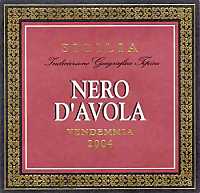
|
|
Nero d'Avola 2004 |
|
| Morgante (Sicily, Italy) | |
| Grapes: Nero d'Avola | |
| Price: € 6.50 | Score: |
| The wine shows an intense ruby red color and nuances of ruby red, moderate transparency. The nose denotes intense, clean and pleasing aromas which start with hints of black cherry and plum followed by aromas of blueberry, vanilla, cyclamen and carob. The mouth has good correspondence to the nose, a slightly tannic attack and however balanced by alcohol, good body, intense flavors. The finish is persistent with flavors of plum and black cherry. This Nero d'Avola ages for 4 months in barrique. | |
| Food Match: Roasted meat, Braised and stewed meat | |
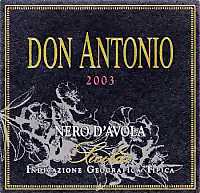
|
|
Don Antonio 2003 |
|
| Morgante (Sicily, Italy) | |
| Grapes: Nero d'Avola | |
| Price: € 20.00 | Score: |
| The wine shows an intense ruby red color and nuances of garnet red, little transparency. The nose reveals intense, clean, pleasing, refined and elegant aromas which start with hints of plum, blackberry and black cherry followed by aromas of blueberry, violet, vanilla, carob, cyclamen, licorice, tobacco and pink pepper. The mouth has good correspondence to the nose, a tannic attack and however balanced by alcohol, full body, intense flavors, agreeable. The finish is persistent with flavors of blackberry and plum. A well made wine. Don Antonio ages for 12 months in barrique followed by 7-8 months of aging in bottle. | |
| Food Match: Game, Roasted meat, Braised and stewed meat, Hard cheese | |
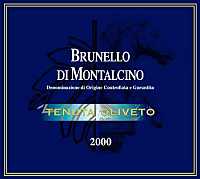
|
|
Brunello di Montalcino 2000 |
|
| Tenuta Oliveto (Tuscany, Italy) | |
| Grapes: Sangiovese Grosso | |
| Price: € 38.00 | Score: |
| This Brunello di Montalcino shows an intense ruby red color and nuances of garnet red, little transparency. The nose reveals intense, clean, pleasing, refined and elegant aromas which start with hints of plum, blackberry and black cherry followed by aromas of blueberry, violet, vanilla, tobacco, cinnamon, licorice, cocoa, pink pepper and eucalyptus. The mouth has good correspondence to the nose, a tannic attack and however balanced by alcohol, full body, intense flavors, agreeable. The finish is persistent with flavors of black cherry, blackberry and plum. A well made wine. This Brunello di Montalcino ages for 30 months in cask followed by 30 months of aging in bottle. | |
| Food Match: Game, Braised and stewed meat, Roasted meat, Hard cheese | |
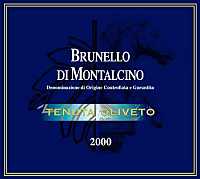
|
|
Brunello di Montalcino Riserva 1999 |
|
| Tenuta Oliveto (Tuscany, Italy) | |
| Grapes: Sangiovese Grosso | |
| Price: € 52.00 | Score: |
| This wine shows a brilliant ruby red color and nuances of garnet red, moderate transparency. The nose reveals intense, clean, pleasing, refined and elegant aromas which start with hints of prune, dried violet and black cherry jam followed by aromas of strawberry jam, raspberry jam, vanilla, tobacco, licorice, cocoa, cinnamon, leather and mace. The mouth has good correspondence to the nose, a tannic attack and pleasing roundness, however balanced by alcohol, full body, intense flavors. The finish is persistent with flavors of prune, black cherry jam and raspberry jam. A well made wine. This reserve of Brunello di Montalcino ages for 3 years in cask followed by 30 months of aging in bottle. | |
| Food Match: Game, Roasted meat, Braised and stewed meat, Hard cheese | |
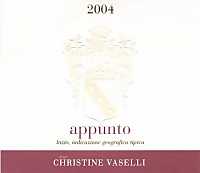
|
|
Appunto 2004 |
|
| Christine Vaselli (Latium, Italy) | |
| Grapes: Canaiolo Nero, Ciliegiolo | |
| Price: € 5.00 | Score: |
| This wine shows an intense ruby red color and nuances of ruby red, little transparency. The nose denotes intense, clean and pleasing aromas which start with hints of blackberry and raspberry followed by aromas of black cherry, strawberry, pomegranate, blueberry and violet. The mouth has good correspondence to the nose, a slightly tannic attack and pleasing crispness, however balanced by alcohol, good body, intense flavors. The finish is persistent with flavors of blackberry, black cherry and raspberry. This wine ages in steel tanks. | |
| Food Match: Cold cuts, Pasta with meat and mushrooms, Sauteed meat | |
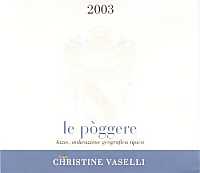
|
|
Le Poggere 2003 |
|
| Christine Vaselli (Latium, Italy) | |
| Grapes: Cabernet Sauvignon (70%), Merlot (30%) | |
| Price: € 18.00 | Score: |
| This wine shows a deep ruby red color and nuances of ruby red, little transparency. The nose denotes intense, clean, pleasing, refined and elegant aromas which start with hints of black cherry, plum and black currant followed by aromas of violet, vanilla, tobacco, cinnamon, chocolate, mace and eucalyptus. The mouth has good correspondence to the nose, a tannic attack and however balanced by alcohol, full body, intense flavors, agreeable smoothness. The finish is persistent with flavors of black cherry, plum and black currant. A well made wine. Le Poggere ages for 12 months in barrique. | |
| Food Match: Roasted meat, Braised and stewed meat, Hard cheese | |
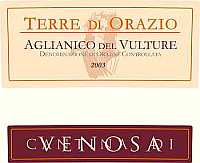
|
|
Aglianico del Vulture Terre di Orazio 2003 |
|
| Cantina di Venosa (Basilicata, Italy) | |
| Grapes: Aglianico | |
| Price: € 8.00 | Score: |
| This wine shows an intense ruby red color and nuances of garnet red, moderate transparency. The nose denotes intense, clean, pleasing and refined aromas that start with hints of black cherry, plum and violet followed by aromas of blueberry, blackberry, vanilla and cinnamon. The mouth has good correspondence to the nose, a tannic attack and however balanced by alcohol, good body, intense flavors. The finish is persistent with flavors of black cherry, plum and blueberry. This Aglianico del Vulture ages for about 15 months in cask followed by at least 6 months of aging in bottle. | |
| Food Match: Roasted meat, Stewed meat, Hard cheese | |
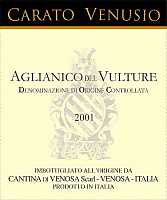
|
|
Aglianico del Vulture Carato Venusio 2001 |
|
| Cantina di Venosa (Basilicata, Italy) | |
| Grapes: Aglianico | |
| Price: € 15.00 | Score: |
| This Aglianico del Vulture shows a brilliant ruby red color and nuances of ruby red, little transparency. The nose denotes intense, clean, pleasing and refined aromas which start with hints of black cherry, plum and blackberry followed by aromas of blueberry, violet, vanilla, tobacco, pink pepper, carob and cinnamon. The mouth has good correspondence to the nose, a tannic attack and however balanced by alcohol, full body, intense flavors. The finish is persistent with flavors of black cherry, plum and blackberry. This wine ages for 12-18 months in barrique followed by at least 6 months of aging in bottle. | |
| Food Match: Roasted meat, Braised and stewed meat, Hard cheese | |
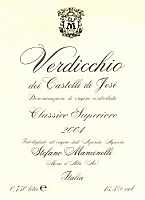
|
|
Verdicchio dei Castelli di Jesi Classico 2004 |
|
| Stefano Mancinelli (Marches, Italy) | |
| Grapes: Verdicchio | |
| Price: € 7.50 | Score: |
| The wine shows an intense greenish yellow color and nuances of straw yellow, very transparent. The nose reveals intense, clean and pleasing aromas that start with hints of hawthorn and apple followed by aromas of almond, pear, citrus fruits and plum. The mouth has good correspondence to the nose, a crisp attack and however balanced by alcohol, good body, pleasing roundness. The finish is persistent with flavors of apple, plum and almond. | |
| Food Match: Pasta with meat and mushrooms, Sauteed white meat, Broiled fish | |
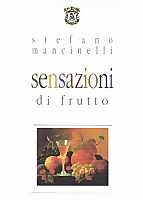
|
|
Lacrima di Morro d'Alba Sensazioni di Frutto 2005 |
|
| Stefano Mancinelli (Marches, Italy) | |
| Grapes: Lacrima di Morro d'Alba | |
| Price: € 10.00 | Score: |
| This wine shows a brilliant ruby red color and nuances of purple red, little transparency. The nose reveals intense, clean, pleasing and refined aromas which start with hints of strawberry, raspberry and blackberry followed by aromas of blueberry, black cherry, rose, violet, cyclamen and plum. The mouth has good correspondence to the nose, a slightly tannic attack and pleasing crispness, however balanced by alcohol, good body, intense flavors, agreeable. The finish is persistent with flavors of strawberry, raspberry and blackberry. This Lacrima di Morro d'Alba is produced with carbonic maceration and ages in steel tanks. | |
| Food Match: Pasta with meat and mushrooms, Sauteed meat with mushrooms | |
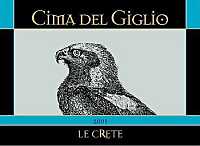
|
|
Colli Amerini Malvasia Cima del Giglio 2004 |
|
| Le Crete (Umbria, Italy) | |
| Grapes: Malvasia Bianca (90%), Trebbiano Toscano (5%), Verdello (5%) | |
| Price: € 7.00 | Score: |
| The wine shows an intense straw yellow color and nuances of straw yellow, very transparent. The nose denotes intense, clean, pleasing and refined aromas which start with hints of apple, pear and plum followed by aromas of hawthorn, hazelnut, litchi, praline, honey and vanilla. The mouth has good correspondence to the nose, a crisp attack and pleasing smoothness, however balanced by alcohol, good body, intense flavors. The finish is persistent with flavors of plum, apple and hazelnut. Cima del Giglio ages for 5-6 months in steel tanks. | |
| Food Match: Pasta and risotto with fish and vegetables, Broiled crustaceans and fish | |
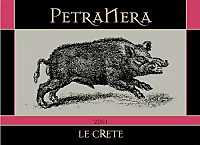
|
|
Colli Amerini Rosso Superiore Petranera 2003 |
|
| Le Crete (Umbria, Italy) | |
| Grapes: Sangiovese (70%), Merlot (10%), Barbera (10%) | |
| Price: € 9.00 | Score: |
| The wine shows a brilliant ruby red color and nuances of garnet red, moderate transparency. The nose denotes intense, clean, pleasing and refined aromas which start with hints of black cherry, violet and plum followed by aromas of blueberry, vanilla, carob and cinnamon. The mouth has good correspondence to the nose, a slightly tannic attack and pleasing roundness, however balanced by alcohol, intense flavors. The finish is persistent with flavors of black cherry, plum and blueberry. Petranera ages for about 6 months in barrique followed by at least 3 months of aging in bottle. | |
| Food Match: Roasted meat, Stewed meat with mushrooms, Hard cheese | |
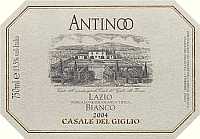
|
|
Antinoo 2004 |
|
| Casale del Giglio (Latium, Italy) | |
| Grapes: Chardonnay (66%), Viognier (34%) | |
| Price: € 9.00 | Score: |
| Antinoo shows a pale straw yellow color and nuances of greenish yellow, very transparent. The nose reveals intense, clean, pleasing and refined aromas which start with hints of apple, banana and toasted followed by aromas of pear, plum, grapefruit, vanilla, hazelnut, coffee, hawthorn and hints of mineral The mouth has good correspondence to the nose, a crisp attack and pleasing smoothness, however balanced by alcohol, good body, intense flavors, agreeable. The finish is persistent with flavors of banana, plum and grapefruit. Antinoo ages in barrique for 6-8 months followed by 6-12 months of aging in bottle. | |
| Food Match: Stuffed pasta with mushrooms, Roasted fish, Roasted white meat | |
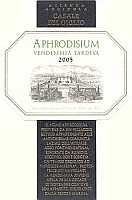
|
|
Aphrodisium 2005 |
|
| Casale del Giglio (Latium, Italy) | |
| Grapes: Viognier, Fiano, Greco Bianco, Petit Manseng | |
| Price: € 21.00 - 500ml | Score: |
| This wine shows a pale golden yellow color and nuances of golden yellow, very transparent. The nose reveals intense, clean, pleasing, refined and elegant aromas that start with hints of grape, apricot and peach followed by aromas of litchi, candied fruit, pear, vanilla, quince, date, almond and honey. The mouth has good correspondence to the nose, a sweet attack and pleasing crispness, however balanced by alcohol, good body, intense flavors, agreeable. The finish is persistent with flavors of grape, peach and honey. A well made wine. Aphrodisium ferments in barrique. | |
| Food Match: Fruit tarts, Hard cheese | |
FazioYoung and dynamic winery, in the last years has concentrated its efforts on the quality of vineyards and of wine making, confirmed by results and awarded by excellent good value wines |
|
In the heart of the province of Trapani, on the top of a mountain from which it is possible to enjoy a wonderful view, surrounded by suggestive streets, history and monuments witness of the passage of many cultures, is located the enchanting city of Erice, in which is located - besides the many things - the Foundation and Center for Scientific Culture “Ettore Majorana” founded by the Nobel prize Antonino Zichichi. Few kilometers from the top of the mountain where it is located Erice, is found Fulgatore, the town where are established Fazio winery's headquarter, not very far from Segesta, renowned for its famous and suggestive temple, one of the few examples of ancient monuments which arrived in good conditions up to our times. In this area - whose territory has been recently recognized as Erice DOC (Denominazione d'Origine Controllata, Denomination of Controlled Origin) - are located Fazio winery's vineyards, in the hills surrounding mount Erice in an enchanting and unique view.
Despite Fazio winery was established in 1998, the history of this winery is long of four generations which have put their commitment with passion and efforts in viticulture and wine making. The long tradition has been continued and renewed by Vincenzo and Girolamo Fazio, who introduced in the winery new structures and wine making techniques, therefore meeting the needs for a modern marketing. The renewal process has initially focused on the management of vineyards done by a team of experts and led by wine maker Giacomo Ansaldi, who worked to the improvement of production, focusing on autochthonous varieties without neglecting the most important international grapes. In order to strengthen the bonds between territory and production, Vincenzo Fazio has been involved in a project which led to the recognition of Erice DOC (Denominazione d'Origine Controllata, Denomination of Controlled Origin), whose production will be recognized by the new disciplinary from vintage 2005 on. The vineyards of Fazio Winery cover an area of about 100 hectares (247 acres), planted in hills at an altitude from 250 and 500 meters (820-1640 feet), in areas specifically selected for their exposition, microclimate characteristics and the geological characteristics of the soil. In these places, in which blow winds from the north and sea breezes, are cultivated the vineyards of Fazio winery and which, after harvesting, will produce their wines. The vineyards are mainly cultivated with the typical autochthonous grapes of Sicily: Inzolia, Grillo, Catarratto as for white berried grapes - including Muscat Blanc - and Nero d'Avola, as for red berried grapes. In the vineyards of Fazio winery are also cultivated the international varieties Merlot, Cabernet Sauvignon and Syrah, also known as Shiraz. However, among the “international” grapes, Fazio winery is particularly involved in the cultivation of Müller Thurgau, planted at an altitude of 500 meters (1640 feet), producing with this grape an interesting wine.
The structure hosting the cellar of Fazio winery includes the most advanced technologies, in respect of the architectural style of Sicily, in harmony with the surrounding nature. The complex is made of two distinct areas. The receptive structure, in which are located the offices and the wine shop, and the productive structure, in which it is also located a large underground cellar. Fazio winery also has cellars used for the aging of wine in which the temperature is constantly controlled. The grapes - soon after harvesting - are vinified according to the type of wine to be made. As for white wines, after destemming, the must is allowed to be in contact with the skins at a temperature of 4° C (39° F), soft crushing of berries and a very slow fermentation at a controlled temperature. As for red wines, the grapes are destemmed first and the skins are left to macerate in the must at a controlled temperature ranging from 25° and 28° C (77-82° F), in variable times and according to the type of wine to be made. In the beginning, the production of Fazio winery was mainly destined to the Italian market, however it took little time to catch the attention of other countries, the wines of Fazio went beyond the borders of Italy. Today the wines of this Sicilian winery are commercialized - besides Italy - in Switzerland, Germany, Belgium, Netherlands, United Kingdom, Norway, Denmark, Hungary, Russia, Poland, Japan, United States of America, Canada, Singapore and Australia. The management of Fazio winery is completely done by the family. Vincenzo Fazio, managing director of the winery, is also in charge for the coordination of production and commercialization; his wife Roberta manages and supervise purchases, supervise the feasibility of materials used in the winery as well as of the image; Girolamo Fazio is in charge for any legal aspect and the relationships with institutions; his wife Lilly is in charge of the commercialization of wines, export and penetration of markets. The production of Fazio winery - with a total yearly production of 700,000 bottles - is made of four ranges: “Linea Classica”, “Linea i Bagli”, “Linea ╔lite” and “Linea Spumanti”. The Linea Classica includes Brusìo, produced with Inzolia and Chardonnay grapes; Gàbal, produced with Nero d'Avola and shortly aged in cask; Montèlimo, produced with Nero d'Avola and Merlot grapes. The Linea i Bagli range is made of Torre dei Venti, produced with Nero d'Avola and aged in cask; Shiraz, aged in cask; three white wines respectively produced with 100% Inzolia, Grillo and Catarratto. The Linea ╔lite is made of Müller Thurgau, one of the best known white wines of Fazio winery; Merlot, aged in barrique; Cabernet Sauvignon, aged in barrique; PietraSacra, produced with Cabernet Sauvignon, Nero d'Avola and Merlot, aged in barrique. Very interesting are the two wines making the spumanti range: Petali Brut, made with Chardonnay and produced with long Charmat method, and Petali Moscato, produced with 100% Muscat Blanc with Charmat method.
|
||||||||||||||||||||
|
Score legend Prices are to be considered as indicative. Prices may vary according to the country or the shop where wines are bought |
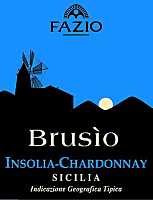
|
|
Brusio 2005 |
|
| Fazio (Sicily, Italy) | |
| Grapes: Inzolia (60%), Chardonnay (40%) | |
| Price: € 5.50 | Score: |
| The wine shows a brilliant greenish yellow color and nuances of greenish yellow, very transparent. The nose denotes intense, clean and pleasing aromas which start with hints of peach, pear and pineapple followed by aromas of hawthorn, apple and broom. The mouth has good correspondence to the nose, a crisp attack and however balanced by alcohol, good body, intense flavors. The finish is persistent with flavors of peach, pear and pineapple. Brusìo ages in steel tanks. | |
| Food Match: Fried fish, Crustaceans appetizers, Pasta and risotto with crustaceans and fish | |
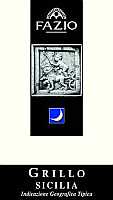
|
|
Grillo 2005 |
|
| Fazio (Sicily, Italy) | |
| Grapes: Grillo | |
| Price: € 6,50 | Score: |
| The wine shows a brilliant greenish yellow color and nuances of greenish yellow, very transparent. The nose reveals intense, clean, pleasing and refined aromas which start with hints of peach, hawthorn and pear followed by aromas of broom, almond, apple and pineapple. The mouth has good correspondence to the nose, a crisp attack and however balanced by alcohol, good body, intense flavors, agreeable. The finish is persistent with flavors of peach, pear and apple. This Grillo ages in steel tanks and for 3 months in bottle. | |
| Food Match: Pasta and risotto with fish, Broiled crustaceans, Sauteed fish | |
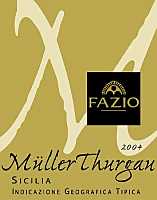
|
|
Müller Thurgau 2005 |
|
| Fazio (Sicily, Italy) | |
| Grapes: Müller Thurgau | |
| Price: € 8,00 | Score: |
| The wine shows a brilliant greenish yellow color and nuances of greenish yellow, very transparent. The nose reveals intense, clean, pleasing and refined aromas which start with hints of peach, grape and pear followed by aromas of orange, pineapple, litchi, yellow rose, broom and apple. The mouth has good correspondence to the nose, a crisp attack and however balanced by alcohol, good body, intense flavors, agreeable. The finish is persistent with flavors of grape, peach and litchi. This Müller Thurgau ages in steel tanks and for 3 months in bottle. | |
| Food Match: Pasta with crustaceans and fish, Broiled crustaceans and fish | |
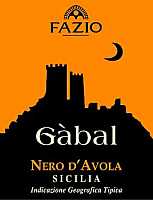
|
|
Gàbal Nero d'Avola 2004 |
|
| Fazio (Sicily, Italy) | |
| Grapes: Nero d'Avola | |
| Price: € 8.00 | Score: |
| The wine shows a brilliant ruby red color and nuances of ruby red, moderate transparency. The nose denotes intense, clean and pleasing aromas which start with hints of black cherry, blackberry and plum followed by aromas of blueberry, violet, carob and tobacco. The mouth has good correspondence to the nose, a slightly tannic attack and pleasing roundness, however balanced by alcohol, good body, intense flavors. The finish is persistent with flavors of black cherry and blackberry. Gàbal ages in cask for some months. | |
| Food Match: Stuffed pasta, Sauteed meat with mushrooms, Broiled meat and barbecue | |
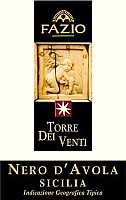
|
|
Torre dei Venti Nero d'Avola 2004 |
|
| Fazio (Sicily, Italy) | |
| Grapes: Nero d'Avola | |
| Price: € 8.00 | Score: |
| The wine shows an intense ruby red color and nuances of purple red, moderate transparency. The nose denotes intense, clean, pleasing and refined aromas that start with hints of black cherry, plum and blackberry followed by aromas of raspberry, blueberry, violet, vanilla, carob and pink pepper. The mouth has good correspondence to the nose, a slightly tannic attack and however balanced by alcohol, good body, intense flavors. The finish is persistent with flavors of black cherry, plum and blackberry. This Nero d'Avola ages in cask for 8-10 months followed by 12 months of aging in bottle. | |
| Food Match: Roasted meat, Broiled meat and barbecue, Stewed meat | |
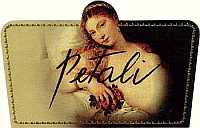
|
|
Petali Moscato 2005 |
|
| Fazio (Sicily, Italy) | |
| Grapes: Muscat Blanc | |
| Price: € 10.00 | Score: |
| The wine shows an intense greenish yellow color and nuances of greenish yellow, very transparent, good effervescence, fine and persistent perlage. The nose reveals intense, clean, pleasing and refined aromas which start with hints of grape and peach followed by aromas of pear, medlar, apple, litchi, pineapple, broom and sage. The mouth has good correspondence to the nose, a sweet, crisp and effervescent attack, however balanced, light body, intense flavors, agreeable. The finish is persistent with flavors of grape, peach and litchi. This sparkling wine is produced with the Charmat method. | |
| Food Match: Cream desserts, Fruit desserts, Panettone, Pandoro | |
| Fazio Casa Vinicola in Erice - Via Capitano Rizzo, 39 - 91010, Fulgatore - Erice, Trapani (Italy) - Tel. +39 923 811700 Fax. +39 932 811654 - Winemaker: Giacomo Ansaldi, Giuseppe Clementi - Established: 1998 - Production: 700.000 bottles - E-Mail: info@faziowines.it - WEB: www.faziowines.it |
Cellar Journal |
|
This section is reserved to wine producers who want to publish news and information about their business, to announce new products or just for communicating to customers information and promotions about their products and activity. Send news to be published to our e-mail address.
|
News |
|
In this section are published news and information about events concerning the world of wine and food. Whoever is interested in publishing this kind of information can send us a mail to our address.
|
Umbrian Cooking and WineCereals, legumes and vegetables: these are the main ingredients of Umbrian cooking, the cuisine of a land far from the sea, humble and genuine however rich of flavors and tastes |
|
Umbria is the only region of peninsular Italy which does not have coastlines bordering the sea, its “central” position, absolutely located in the inland of the country and characterized by the beauty of natural views, have made it call the green heart of Italy. Being far from the sea means - in Umbria as well as in other areas having no coastlines - the absence of fish from tables. However in Umbria is found the fourth lake of Italy, Trasimeno lake, and the region has many rivers, including Tiber which flows from north to south crossing the whole length of the region. Thanks to them, Umbrian gastronomy can count many recipes based on fish, of course, sweet water fish. Being far from the sea also means the presence on the tables of products of the earth and, last but not the least, meat, in particular pork meat. In Umbrian cooking are in fact abundantly present cereals, legumes and vegetables of any kind, wild aromatic herbs and, whenever possible, meat - pork and lamb - and sometimes sweet water fish. The only exception for sea fish is represented by dried salted cod that, after having been dried, it can be easily kept.
Umbrian cooking is simple in its definition, it is based on the genuineness of simple things capable of surprising even the palate of the most refined and exacting gourmets. A cuisine having its origins from the peasant world, made of few and poor things, however majestically seasoned with that bit of fantasy and intelligence which allowed the compensation to the opulence offered by wellness. However, in its apparent gastronomical poverty, Umbria is a land extremely rich in culinary delicacies, including his majesty olive oil, king truffle, woods capable of giving mushrooms, wild and aromatic herbs: delicacies which do not having less than other foods. If we observe the placid and suggestive views of Umbria, it could be noticed endless hills colored with the gray-green of olive trees' leaves, neat vineyards from which are being obtained excellent wines. But also large fields colored with the gold of wheat spikes, sunflowers and corn. Moreover, the green heart of Italy has a particular predilection for two foods: cereals and legumes - in particular broad beans and beans - something which makes usually define the people of Perugia with the funny saying «Perugino bean eater, the more he eats, the more they are good».
|
||||||||
|
The predilection of Umbrians to the consumption of cereals and legumes, as well as vegetables, is probably a heritage having its origins in the ancient times of Etruscans, the majestic people which founded Perugia and who established in the left bank of Tiber river until the beginning of the colonization of ancient Romans. The rich consumption of cereals - such as wheat, spelt, barley and oat - is still today very common in Umbria, proven by the richness of the countless soups made with these cereals. Also the consumption of legumes is very high, such as beans, chickpeas, broad beans and lentils, as well as the excellent fagiolina del lago Trasimeno - locally called risina because of its white and tiny seed similar to rice - an exquisite and tasty Umbrian legume. Fagiolina del Lago Trasimeno is not the only exquisite legume we can find in Umbria. Very renowned and looked for is also the extraordinary lentil from Castelluccio di Norcia, with its unmistakable taste and with seeds of tiny size, this legume is present in this area for more than 5000 years, as it is proven by some seeds of lentils found in some tombs of the neolithic era. With cereals - just like in other Italian regions - are made many buns and breads, including the renowned and exquisite torta al testo, a monument of extraordinary and tasty simplicity that, also in this case, has its origin from the ancient times of Etruscans. Torta al testo is a sort of a flat bread, simply made of wheat flour, water, a little of olive oil and very little of salt. In its original version, the use of yeast was not part of the recipe, however the use of beer yeast or sodium bicarbonate became common during the course of centuries. The secret and the absolute protagonist of torta al testo, very simple and poor in its ingredients, is testo, that is a disc of stone, heat on embers and on which it is put the torta to be cooked, while making holes on its surface with a fork in order to avoid its excessive rising. Torta al testo, besides being the traditional and tasty replacement for bread in Umbria, it is generally stuffed, when it is still hot and after having been cut in slices, with the tasty ham of this land, boiled vegetables - here usually called “erba” - roasted sausages, cheese and any other thing suggested by fantasy. Another delicacy is the tasty torta di Pasqua (Easter cake), prepared with flour, Parmesan and pecorino cheese, eggs and lard, consumed during Easter and usually stuffed with capocollo - one of the many cold cuts of Umbria - or used to accompany hard eggs. From the Etruscan era has also reached our times, together with many other recipes which have evolved in the course of the centuries, the traditional pasta dolce (sweet pasta), typically prepared and consumed in the vigil of Christmas. It is usually prepared with maccheroni, which were in ancient times seasoned with breadcrumbs, walnut kernels and honey, to which, with time, have been added cinnamon, cocoa powder and alchermes. The history and the roots of Umbrian cooking are pretty singular, it could be defined as a cooking which has evolved in an autochthonous way, as it is hard to find influences from the culinary cultures of the bordering regions. Something similar has also happened to the dialects of Umbria, including the dialect of Perugia, with evident influences of Latin, which is however different from any other dialect, including the ones which are spoken at few kilometers of distance, therefore confirming, in a sense, the historical custom of the region to be close. The same can be said for cooking, whose recipes are not found elsewhere, maybe for the richness of that ancient people who strongly influenced the development, culture and traditions of Umbria.
|
||||
|
In the Umbrian cooking, besides the vast presence of the products of the earth, are also used the many products spontaneously growing in woods, such as mushrooms, asparaguses, wild herbs and fruits, aromatic black and white truffles. Not only foods of vegetal origin, of course. In Umbria there is a long tradition associated to the processing of meat, cold cuts and salami, in particular in the area of Norcia, the city from which the terms norcineria and norcino come, used to define the skilled artisan capable of processing pork meat and to make excellent cold cuts and salami. Pork is the queen meat of Umbria, followed by ovine meat, animals from which - besides the other things - is obtained the milk for the production of excellent pecorino cheese, made all over the territory of the region, however, also in this case, Norcia represents one of the most important place for the production of cheese in Umbria. Despite Umbria is the only region of peninsular Italy having no coastlines, its people is jokingly called “magnalische” (fishbones eaters) as well as “magnalasche”, because of their predilection for one of the most common fishes of Trasimeno lake. “Lasca” is the name used here to call “alborella”, a sweet water fish of silver color, usually consumed when it is still of a small size - for this reason it is commonly called “laschina”, small “lasca” - typically fried. Another fish consumed in Umbria is bass fish, usually fried or used for making some soups. Also eel plays a fundamental role in Umbrian cooking, in particular in the areas of Trasimeno lake. Here eel is grilled or cooked on a spit, and in particular for the preparation of tegamaccio, in which eel is stewed with fresh tomatoes. Another delicacy of Trasimeno lake is regina in porchetta, that is roasted carp and aromatized with a battuto, a mixture of lard, garlic, wild fennel, rosemary and black pepper. In the areas of the lakes Trasimeno, Corbara and Piediluco, are typical the recipes made with tench - usually prepared with rice and pasta - and pike, typically roasted or grilled. The only sea fish which is part of the culinary tradition of Umbria is dried salted cod - which arrived in the region dried and salted - usually stewed or, typical in the province of Perugia, cooked with prunes. As for meat, pork is the most present and the most used one in Umbrian cooking. Pork meat is usually broiled, typical are also pork sausages, typically on the spit or grilled. In Umbria, like it is said in other places, nothing of pork is thrown away. Here it is in fact very common using pork skin, here called codica, in particular the one of ham, very tasty, and used for making one of the most classical recipes of Umbria: fagioli con le codiche (beans with pork's skin). In Umbria pork also means a long tradition and skilled production of cold cuts and salami, from the tasty hams - which are usually consumed with torta al testo or the simple bread of this land - as well as fresh and dried sausages, salami, the most famous one is corallina, and mazzafegati, sausages made of pork liver, and mortadella Umbra, different from the renowned version from Bologna. As for salami and cold cuts, typical are capocollo - produced with the back of the pork and aromatized with spices, herbs and garlic - pancetta (pork's belly), also rolled and here called ventresca, guanciale (pork's cheek), here called barbozzo. Because nothing of pork is thrown away, typical is also coppa, produced with the head, snout, ears and skin of pork, finely cut and aromatized with salt, black pepper, cinnamon, nutmeg and orange skin, compressed and boiled in a bag of fabric. In Umbria it is also common the consumption of boar meat, from which are obtained hams and sausages, and typically braised after having been marinated in a full bodied red wine for a long time. As for other meats, in Umbria are also consumed ovine meats - roasted, grilled, stewed and casserole - as well as game, such as hare, pheasant and thrush. Among the most important meat are also typical the ones of chicken, goose, guinea-fowl, pigeon and rabbit, usually roasted and pillottati, a particular Umbrian technique consisting in using hot and boiling lard drops, in order favor its penetration in the meat during cooking therefore making it very tasty. Very common are also chicken giblets - here called rigaji - stewed or braised, as well as for the preparation of the typical Umbrian patê (crostini), and a ragout used for seasoning tagliatelle con i rigaji (tagliatelle with giblets). As for pasta, the ones typical in Umbria are very simple and poor, made with wheat flour and water, such as in case of umbricelli and strangozzi in the province of Perugia, or ciriole typical in the area of Terni. Among egg pasta, the most common is tagliatelle. As for typical Umbrian stuffed pasta are mentioned cappelletti (small hats), different from the ones prepared in Emilia-Romagna. During holidays are typical lasagne and cannelloni, pasta rolls stuffed with minced and aromatized meat, cooked in the oven after having been seasoned with ragout. In Umbria a typical association for pasta are legumes, such as broad beans, beans and lentils. Countless are also the soups in which are used both cereals and legumes, as in the case of the tasty imbrecciata of Perugia. It should be noticed that here in Umbria soups are always enriched with the generous and aromatic local olive oil. As for desserts, in Umbria they are typically prepared with the same simplicity of the other dishes. Simple cakes, although tasty, most of the cases prepared in occasion of holidays. Strufoli, frappe, torciglione, pinoccate, ciaramicola, torcolo, torcolo di San Costanzo, rocciata di Assisi, fregnacce, panpepato di Terni, torta di Pasqua dolce, fave dei morti, tozzetti and pinolate: just a short review of the many sweet and simple delicacies of Umbria. Recipes of which should be talked in a more thoroughly way, including historical and gastronomical aspects, as well as the rich culinary culture of Umbria “green heart of Italy”, a small region, but big for tradition, culture, art and history, and not only in the dish.
|
|
The enogastronomical richness of Umbria is also found is the good selection of wines produced in the region. Despite Sagrantino - the magnificent and extraordinary Umbrian grape - is recently getting more and more popular, Umbria also offers other excellent wines which can be perfectly matched to its cooking. Long is in fact the wine making tradition of Torgiano, in the province of Perugia, and Orvieto, in the province of Terni. The many and tasty salami of Umbria - usually consumed with torta al testo or with the simple Umbrian bread - are well matched to some full bodied wines produced with the white Grechetto, an autochthonous grape of Umbria, as well as red wines from Colli Perugini or Colli Altotiberini. Cereals, one of the fundamental foods of Umbrian cooking and which are expressed in the countless soups, can be well matched to the many white wines of the region, such as Torgiano Bianco, Malvasia Bianca dei Colli Amerini and the whites of Orvieto. As for the tasty torta al testo, its matching is mainly determined by the ingredients used for stuffing: red wines for sausages, cheese and some salami, white wines for vegetables. Also the matching to legumes is mainly determined on how they are prepared. Pasta with broad beans or with legumes can be matched to Grechetto as well as to some red wines of the province of Perugia. The preparation of stewed beans, in particular, fagioli con le codiche, will be well matched to good bodied red wines, as well as the pasta prepared with the rich and robust Umbrian ragout, frequently made with chicken giblets. Meat dishes, usually roasted, broiled, grilled or braised, can be matched to red wines from Torgiano, reds from Colli Amerini, Montefalco and Colli del Trasimeno. The robust game will be well matched to Sagrantino di Montefalco and Torgiano reserve, as well as full bodied wines from Colli del Trasimeno. As for desserts, the enological production of Umbria mainly offers Vin Santo (Holy Wine) and Sagrantino Passito di Montefalco, wines which can be also matched to Umbrian hard pecorino cheese. However it is Vin Santo the wine which is mainly matched in Umbria to desserts, such as in the case of tozzetti, tasty biscuits with almonds and anise.
|
AsparagusComing from Asia, common in the Mediterranean area and in Europe, it was appreciated by Egyptians, Greeks and Romans, both as an officinal plant and as a refined and delicate vegetable |
|
Asparagus, (asparagus officinalis) comes from Asia, where it grew as a wild plant and was known since the times of Egyptians, whose spread it all over the Mediterranean area. The first evidences of asparaguses are found in a document written 300 years before Christ by Theofrastus from Ereso - a Greek philosopher, scholar and friend of Plato, disciple and successor of Aristotle - in his “History of Plants”, a botanic work in 9 volumes. Marcus Portio Cato (234-149 b.C.) mentioned it in its book “De agricoltura”, describing the cultivation techniques. Also the famous Latin naturalist Pliny the Elder (23-24 - 79 A.D.) wrote about the gastronomical qualities and the cultivation techniques of asparaguses in his monumental work “Naturalis Historia”. Ancient Romans called it asparagus and they appreciated it both for cooking as well as for its medical properties, countless are the recipes based on asparaguses mentioned in the most famous cookbooks of those times. Decimus Iunius Iuvenalis (60 - 140 A.D.), in one of his writings, illustrated one of his meals: “…a fat kid…some mountain asparaguses, big eggs”.
Despite the cooking of asparaguses is today a custom associated to their consumption, it seems ancient Romans thought differently about this: Suetonius, in describing the rapidity of an action done by Augustus, wrote it took less time than it was usually needed for boiling asparaguses (“citius quam asparagi coquantur”). Martial (40 - 104 A.D.) praised the asparaguses cultivated in the coastlines of Ravenna, with a tender pulp, exported for the enjoyment of rich people. During the Middle Age, asparagus was mainly cultivated for its medical properties, in particular for its depurative and diuretic properties. The spreading of asparagus as a vegetable begins in the 1500's, in France and in Italy, but as it was not easy to cultivate, it remained for a long time a luxury food. King Louis XIV was particularly greed of asparaguses and he was used to order the botanists of his court to cultivate it all year long. Only with the arrival of the 1600's we will find the first evidences of the cultivation of asparaguses. Among the main asparaguses producers of the world there is China, Italy, Greece, France, Spain, Germany and Netherlands. Asparagus is mainly appreciated and cultivated in China, in fact, here it is found the highest production of the world for 70% of the whole planetary production.
|
||||||||
|
Asparagus belongs to the family of liliaceae, it is a perennial herbaceous plant, with a short underground rhizome, with pulpy roots. In springtime, young buds - called spears, that is what we usually call asparaguses - begin to grow and to come out from the ground. During the period they remain underground, spears have a white color, and as they come in contact with sun light, they get a pink-purple color, and then a more or less deep green color. The spears are the edible part of the plant, tender and pulpy with a basically sweet taste, in case they are not harvested, they can reach a height of about 1.5 meters (5 feet). The culture of asparagus is generally done in fields, however it can be cultivated in greenhouses as well. Among the most common commercialized varieties are mentioned:
Among the most common hybrids are mentioned the varieties Gladio, Mars, Atlas and UC157. The many varieties of asparagus are used in different ways: Asparagus tenuifolius is cultivated for nutritional purposes, Asparagus plumosus is used for flower bouquets, Asparagus sprengeri is used as an ornamental plants for balconies and stairs. After having been harvested or bought, and before consuming them, it is necessary to remove the base, hardened by fibers, by using a sharp knife, peeling the stem from the tip towards the base in order to eliminate the fibrous part. Asparagus is a very dietetic food, in fact 100 grams of asparaguses provides 29 Kcal and it is almost completely edible, about 87%. One hundred grams of asparaguses contain 91.4 grams of water, 3.6 of proteins, 0.2 of fats, 3.3 of sugars and 2.1 of fibers. The same quantity of asparaguses contain: 1.2 mg of iron; 2.5 mg of calcium; 0.2 mg of vitamin B1; 0.29 mg of vitamin B2; 1 mg of vitamin PP; 82 mg of vitamin A; 10 mg of vitamin C.
|
|
Asparaguses are rich in fibers, vitamins A, B, B2, C, aminoacids, carotenoids, mineral salts, calcium and phosphorus, and they are low in calories. They also contain asparagine - or aspartic acid - which gives urine its typical smell after having consumed asparaguses. The characteristic smell of the urine is strictly associated to renal efficiency: in case the renal system is efficient, the smell can be perceived in the next urination after the ingestion of asparaguses. Asparaguses reduce the stagnation of water, they are therefore diuretic and depurative, thanks to the presence of purine and uric acid, moreover, it seems they stimulate appetite. They are advised for the cure of cellulitis and to whoever suffering hypertension. They are however contraindicated to anyone affected by renal and prostatic disturbs, absolutely forbidden to anyone suffering renal stones, cystitis, gout and renal inflammations. The roots of asparagus are indicated for people suffering heart problems, to get rid of the water stagnating in tissues, because of the lack of a proper blood circulation. It seems the best way to take the best advantages from the diuretic properties of asparagus is decoction.
|
|
Before consuming asparaguses it is always good to wash them. The season of asparaguses begins at the end of March until May and June. After this period, the production is ensured by greenhouses and, sometimes, by productions coming from other countries. Asparaguses are harvested as they begin to sprout from the earth, when they are still young and tender. The best way to fully appreciate their qualities is to consume them when they are fresh, with solid and closed tips: by trying to bend an asparagus, in case it is fresh, it should break. Before purchasing asparaguses, it is good to check the sprouts out, they must be fresh, straight, hard, intact and with no bruises. The stem must not be woody, the spears making the pack should be of the same length. Asparaguses can be kept in the refrigerator, in the vegetable area, wrapped in a humid cloth, where they can kept up to 4 days. Outside the refrigerator, it is best to keep the stems in cold water where they can live up to 24 hours. Asparaguses of big size are more suited for boiling, whereas the smaller ones are suited for different recipes, such as omelettes, risotto, lasagna, pasta and meat. Asparaguses with a dull aspect and with woody stems should be avoided, as these two factors are the signal of old spears. In order to keep their aroma and to limit the loss of nutritional elements, steaming is the best way for cooking asparaguses.
|
||||
AquavitaeReview of Grappa, Distillates and Brandy |
|
|
| Distillates are rated according to DiWineTaste's evaluation method. Please see score legend in the "Wines of the Month" section. |
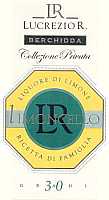
|
|
Limoncello Collezione Privata |
|
| Lucrezio R. (Sardinia, Italy) | |
| Raw matter: Lemon Skins | |
| Price: € 15.00 - 50cl | Score: |
| This liquor shows a pale greenish yellow color, transparent and not limpid, typical. The nose denotes intense, clean and pleasing aromas of lemon skin and lemon juice with almost imperceptible alcohol pungency. In the mouth has intense flavors with moderate alcohol perception which tends to dissolve rapidly, sweet, pleasing acidity and with intense flavor of lemon skin. The finish is persistent with flavors of lemon skin and lemon juice. Produced by maceration of lemon skins. Alcohol 30%. | |
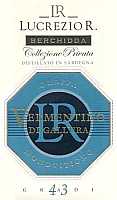
|
|
Grappa Vermentino di Gallura Collezione Privata |
|
| Lucrezio R. (Sardinia, Italy) | |
| Raw matter: Pomace of Vermentino | |
| Price: € 20.00 - 50cl | Score: |
| This grappa is colorless, limpid and crystalline. The nose reveals intense, clean and pleasing aromas of pear, almond, hazelnut, licorice and peach, with almost imperceptible alcohol pungency. In the mouth has intense flavors with perceptible alcohol pungency which tends to dissolve rapidly, agreeable roundness, balanced sweet hits. The finish is persistent with flavors of pear, hazelnut and licorice. This grappa is distilled with a bainmarie alembic still. Alcohol 43%. | |
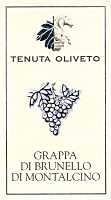
|
|
Grappa di Brunello di Montalcino |
|
| Tenuta Oliveto (Tuscany, Italy) | |
| (Distiller: Distilleria Capovilla) | |
| Raw matter: Pomace of Sangiovese Grosso | |
| Price: € 12.50 - 20cl | Score: |
| This grappa is colorless, limpid and crystalline. The nose denotes intense, clean, pleasing and refined aromas of violet, black cherry, plum, licorice, raspberry and hazelnut with almost imperceptible alcohol pungency. In the mouth has intense flavors with perceptible alcohol pungency which tends to dissolve rapidly, pleasing smoothness, balanced sweet hint, agreeable. The finish is persistent with flavors of plum and black cherry. This grappa is distilled with a bainmarie alembic still. Alcohol 44%. | |
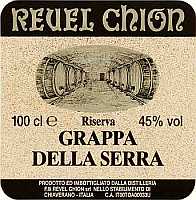
|
|
Grappa della Serra Riserva |
|
| Revel Chion (Piedmont, Italy) | |
| Raw matter: Pomace of Barbera, Neretto and Erbaluce | |
| Price: € 16.00 - 70cl | Score: |
| This grappa shows a pale straw yellow color, limpid and crystalline. The node denotes intense, clean and pleasing aromas of honey, raspberry, blackberry, pear, vanilla and dried fig with almost imperceptible alcohol pungency. In the mouth has intense flavors with perceptible alcohol pungency which tends to dissolve rapidly, pleasing roundness, balanced sweet hint, agreeable. The finish is persistent with flavors of honey, dried fig and raspberry. This grappa is aged for more than 18 months in cask and it is distilled with a steam operated alembic still. Alcohol 45%. | |
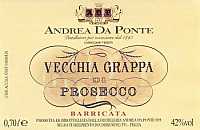
|
|
Vecchia Grappa di Prosecco Barricata 8 Annate |
|
| Andrea Da Ponte (Veneto, Italy) | |
| Raw matter: Pomace of Prosecco | |
| Price: € 16.00 - 70cl | Score: |
| This grappa shows a pale golden yellow color, limpid and crystalline. The nose reveals intense, clean, pleasing and refined aromas of vanilla, tobacco, pear, apple, licorice, peat smoke and honey with almost imperceptible alcohol pungency. In the mouth has intense flavors with perceptible alcohol pungency which tends to dissolve rapidly, pleasing smoothness, sweet balanced hint, agreeable. The finish is persistent with flavors of honey, peat smoke and licorice. This grappa is produced with 8 different vintages, aged from 4 to 12 years in barrique, and distilled with a bainmarie alembic still. Alcohol 42%. | |
Wine Parade |
|
|
| The best 15 wines according to DiWineTaste's readers. To express your best three wines send us an E-mail or fill in the form available at our WEB site. |
| Rank | Wine, Producer | |
|---|---|---|
| 1 |
| Trento Talento Brut Riserva Methius 1998, Dorigati (Italy) |
| 2 |
| Colli Orientali del Friuli Rosazzo Bianco Terre Alte 2002, Livio Felluga (Italy) |
| 3 |
| Riesling Central Otago 2004, Felton Road (New Zealand) |
| 4 |
| Brunello di Montalcino 1999, Castello Banfi (Italy) |
| 5 |
| Amarone della Valpolicella Classico 1998, Santa Sofia (Italy) |
| 6 |
| Amarone della Valpolicella Classico 2000, Zenato (Italy) |
| 7 |
| Wine Obsession 2001, Vignamaggio (Italy) |
| 8 |
| Aglianico del Vulture La Firma 2002, Cantine del Notaio (Italy) |
| 9 |
| Palazzo della Torre 2000, Allegrini (Italy) |
| 10 |
| Notarpanaro 1999, Taurino (Italy) |
| 11 |
| Chianti Classico Riserva Novecento 2000, Dievole (Italy) |
| 12 |
| Montepulciano d'Abruzzo Riparosso 2001, Illuminati (Italy) |
| 13 |
| Nero al Tondo 2001, Ruffino (Italy) |
| 14 |
| Chablis Grand Cru Les Clos 2002, Domaine Billaud-Simon (France) |
| 15 |
| Rêve 2001, Velenosi Ercole (Italy) |
| |||||||
Privacy Policy | |||||||


| Copyright © 2002-2024 Antonello Biancalana, DiWineTaste - All rights reserved |
| All rights reserved under international copyright conventions. No part of this publication and of this WEB site may be
reproduced or utilized in any form or by any means, electronic or mechanical, without permission in writing from DiWineTaste. |